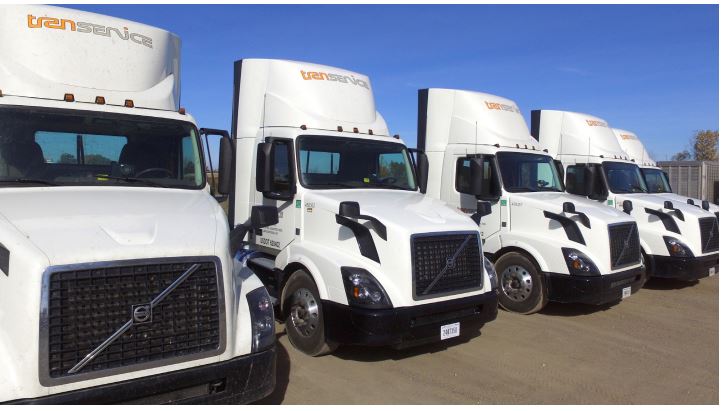Transcending Data With BOLT, Transervice turns information into action for its customers
It’s a simple statement, but it sums up one reason why Transervice is so successful. “In our business, it’s never the what, it’s the why,” explained Joe Evangelist, executive vice president for Transervice. “What is what happened; why is understanding the reasons for what happened and then developing plans to improve the situation. But you can only come up with a solution if you have good data. It allows you to see trends and ways to improve customer operations. That’s the gold.” With a footprint throughout the United States and Canada, Transervice owns, operates and manages more than 24,000 pieces of equipment though 126 locations. Started in 1969 in New York with a single beverage customer—providing maintenance services—the company branched into fullservice leasing in 1972 and began offering dedicated contract carriage in 1985.
Today, the dedicated portion of Transervice’s portfolio represents half its business. According to Evangelist, the company continues to grow its customer base—and many of its customers have been working with Transervice for 30-plus years. “We have an open-book partnership with customers and are transparent with cost management,” he said. “Our customers know exactly what they’re getting. Nothing is hidden. When we put programs together, we start with a clean sheet of paper and provide a solution that fits the customer’s needs. It’s very flexible and custom—they don’t conform to us, we conform to them.” “That’s why we preach, ‘It’s never the what, it’s the why,’” Evangelist said. “The information we get from BOLT System plays a big role in that.”
Transervice has been using BOLT to help manage its dedicated fleet for several years. According to Tom Poduch, Transervice’s director of logistics design, flexibility and a customer-driven approach separate BOLT from other fleet management providers. “BOLT has the same philosophy as we do,” Poduch said. “They ask what we and our customers need, and they deliver. In some of our dedicated contracts, we inherit technology that our clients have already invested in. For example, a client may want us to utilize their existing ELDs or integrate with an established WMS.
BOLT is agnostic and works with different platforms—you’re not pushed toward one system. It’s easy to integrate.” Through BOLT, Transervice has the tools to manage and analyze the fleet. “With BOLT, we are able to collect communal data—route information, workflow activity and loads,” said Poduch. “Customers can tender us loads automatically through EDI. Our dispatchers then know our customer’s expectations and can assign the resources through BOLT. It’s all easily viewed on just one screen. What’s also exciting is that we’re in the process of aggregating information from our brokerage division into BOLT. We will be able to expand our network visibility and assign backhauls through BOLT while better utilizing our fleet.

“With BOLT, we collect customer load and route information automatically through EDI. Our dispatchers know our customer’s expectations and can assign resources through BOLT. It’s easy for us to integrate.” —Tom Poduch, Transervice
This is another way we’re working hard for our dedicated customers: we manage their fleet to reduce empty miles.” Once information is captured, BOLT can streamline billing and payroll, taking administrative burdens away from other departments. What’s more, BOLT can document vehicle and driver performance indicators. “For example, it allows us to identify higher mileage vehicles and route accordingly to balance out miles,” said Poduch. “And we can input driver information and time-off preferences to effectively manage wheel time.” Load management and delivery times are also tracked vigilantly.
When it comes to Transervice’s dedicated contract carriage business, one of the company’s “secret sauces”—data—comes into “When one of our trucks starts a route, a message is automatically sent to each individual delivery point on that route, and an estimated time of delivery is given,” said Poduch. “A second message is sent to the next subsequent stop once the previous shipment is delivered, and an updated ETA is given. If there is an adjustment—either an early delivery possibility, or a delay—a third message is sent out. The bottom line is that delivery information is vital. If there is an early delivery possibility, we want to give the receiving party the opportunity to set up to receive the load.” While that’s the micro view, Poduch said his dispatchers also see the macro (and trend) view. “On our screen, we see all our trucks for our dedicated customer and can view with visual color indicators—green through red— how our freight is moving. We can see how weather patterns, traffic issues and, more recently, storms and wildfires impact our shipments. We can adjust in real time.” Typically, Evangelist said Transervice has monthly or quarterly business reviews with each of its dedicated customers where data and performance metrics are shared. “We use data to make our customers more efficient,” he said. “With BOLT, there is so much information that can be taken, measured, and then presented in an easy to understand fashion.” Data is one thing; easily understanding it is another. “All told, BOLT gives us the tools we need to manage and continually improve for our customers,” he said. “In some cases, we can show that we can do more deliveries with fewer assets. That may mean a reduction in our vehicle count with that customer, but it’s ultimately best for their operation. And if it’s better for them, it’s better for us. It’s being a partner in the truest form of the word.” z To learn more about Transervice visit www.transervice.com

